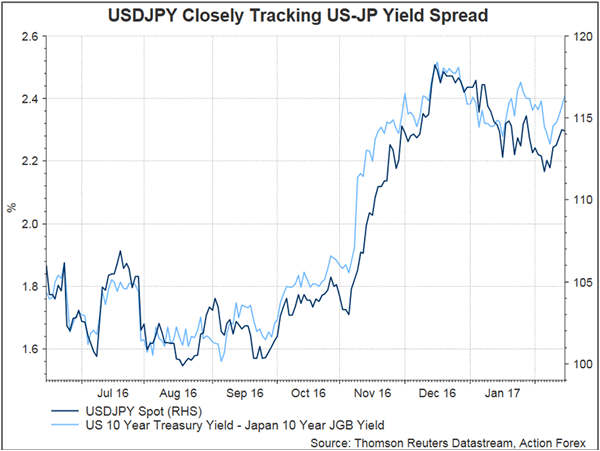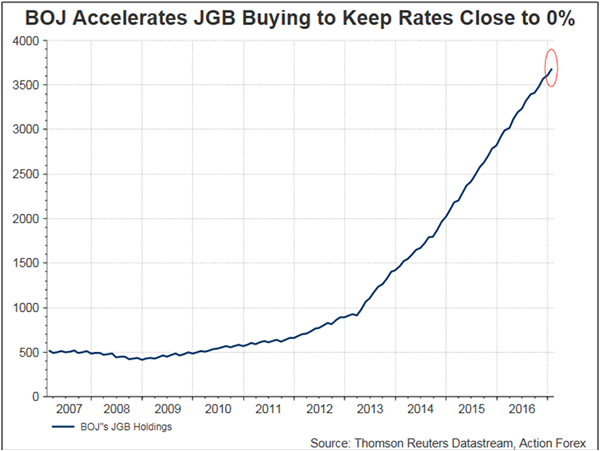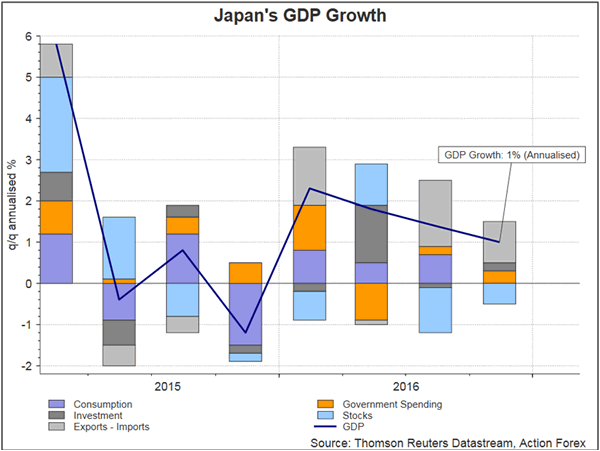USDJPY’s rally since early February indicates that the correction from the 2016-peak (118.66) made on December 15 is ended at 111.57 on February 7. We remain bullish over the currency pair (i.e. expecting Japanese yen to weaken against US dollar). As we mentioned in our January report, reflation trade, driven by US President Donald Trump’s pro-growth policy, such as infrastructural spending, tax cut and deregulations, has driven USD’s rally against major currencies since Trump’s victory. Hopes that the measures would drive US growth and inflation have lifted speculations on Fed funds rate hikes this year, sending Treasury yields and USD higher. Meanwhile, BOJ’s yield curve targeting policy, announced in September last year, would keep the 10-year JGB yields close to 0%. These would help accelerate divergence of Japanese yields from those in the US, pressuring Japanese yen. Recent developments appear to have reinforced such conviction.

Trump-Abe Summit and BOJ policy
The market was apparently relieved after the meeting between US President Donald Trump and Japanese Prime Minister Shinzo Abe on February 10. Traders were once concerned about a politically-triggered Japanese yen appreciation. Yet, there was no touch on trade imbalances or exchange rate. Abe confirmed on Wednesday (Feb 15) that Trump did not complain about the weakness in yen and BOJ’s yield curve control policy. As he spoke before the upper house, Abe noted that ‘Trump shared the view that our monetary policy is not for currency manipulation but for ending deflation". We also notice that BOJ has strengthened its tone on monetary easing following the summit. Governor Haruhiko Kuroda noted that there remains "considerable distance to the 2% price stability target’ and affirmed that he stood ready to cut interest rates if the economy worsens. Indeed, BOJ bought 9.7 trillion yen (book value) of JGBs in January, up from 9.4 trillion yen a month ago. The average maturity of JGB purchased in January was 8.3 years. BOJ’s shares in the JGB market rose to another record of 41.8% in value terms last month. This is evidence of the central bank’s commitment to the yield curve targeting policy. Kuroda’s recent remark on the exchange rate was marked by the comments that ‘currency rates move on various factors… It’s wrong to think currency rates move by monetary policy alone".

Janet Yellen’s Testimony
Fed Char Janet Yellen’s two-day Congressional testimony was viewed as a modestly hawkish one, fueling expectations for a March rate hike. Indeed, following her second day testimony, the OIS has priced in a 48% of rate hike next month, up from 37% a few days ago, while Bloomberg’s estimate has suggested a 42% chance, up from 30% previously. While reiterating that all meetings are ‘live’ for a rate hike, Yellen warned that waiting too long to remove accommodation would be unwise’. She also emphasized that the Fed’s monetary policy stance is not based on ‘speculations’ about fiscal policy. The policy decisions have been driven by the economy’s ‘solid progress’. According to Yellen, ‘incoming data suggest that labor market conditions continue to strengthen and inflation is moving up to +2%, consistent with the Committee’s expectations’. At the upcoming meetings, policymakers would ‘evaluate whether employment and inflation are continuing to evolve in line with these expectations, in which case a further adjustment of the federal funds rate would likely be appropriate’.
We expect expectations for a looser US fiscal policy, together with a tighter monetary policy, would support USDJPY. We are monitoring market developments and look to upgrade our USDJPY forecasts in coming weeks. Risks to our bullish outlook include BOJ’s tapering and lifting of its yield target, as well as improvement in Japanese economic outlook.













